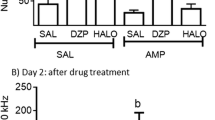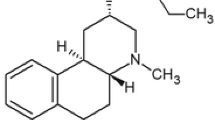Abstract
Biphasic effects of bromocriptine (2.0, 5.0, 10.0, and 20.0 mg/kg IP) on locomotion were quantified in photocell activity boxes in rats. Following early suppression of activity, bromocriptine produced a clear, dose-dependent increase in locomotion that lasted several hours. When a low dose of bromocriptine (5.0 mg/kg) was administered daily over a 3-week period, the locomotor-activating effects of the drug showed progressive enhancement over days. The sensitization was environment specific; rats administered bromocriptine six times in the home cage showed no sign of a sensitized response to bromocriptine when subsequently tested in the activity box. Thus, selective stimulation of D2 receptors stimulates locomotion and sensitizes animals to subsequent injections, just as do the indirect-acting dopamine agonists cocaine and amphetamine.
Similar content being viewed by others
References
Barone P, Davis TA, Braun AR, Chase TN (1986) Dopaminergic mechanisms and motor function: characterization of D-1 and D-2 dopamine receptor interaction. Eur J Pharmacol 123:109–114
Bartoletti M, Gaiardi M, Gubellini G, Bacchi A, Babbini M (1983) Long-term sensitization to the excitatory effects of morphine. Neuropharmacology 22:1193–1196
Beninger RJ, Hahn BL (1983) Pimozide blocks the establishment but not expression of amphetamine-produced environment-specific conditioning. Science 220:1304–1306
Beninger RJ, Herz RS (1986) Pimozide blocks establishment but not expression of cocaine-produced environment-specific conditioning. Life Sci 38:1425–1431
Browne RG, Segal DS (1977) Metabolic and experiential factors in the behavioral response to repeated amphetamine. Pharmacol Biochem Behav 6:545–552
DiChiara G, Imperato A (1988) Drugs abused by humans preferentially increase synaptic dopamine concentrations in the mesolimbic system of freely moving rats. Proc Natl Acad Sci USA 85:5274–5278
Drew KL, Glick SD (1989) Environment-dependent sensitization to amphetamine-induced circling behavior. Pharmacol Biochem Behav 31:705–708
Drew KL, Glick SD (1990) Role of D-1 and D-2 receptor stimulation in sensitization to amphetamine-induced circling behavior and in expression and extinction of the Pavlovian conditioned response. Psychopharmacology 101:465–471
Eikelboom R, Stewart J (1982) The conditioning of drug-induced physiological responses. Psychol Rev 89:507–528
Hassan MN, Higgins D, Traub M, Fahn S (1986) Chronic treatment with bromocriptine induces behavioral supersensitivity in rats. Life Sci 39:513–518
Heikkila RE, Orlansky H, Cohen G (1975) Studies on the distinction between uptake inhibition and release of (3-H)dopamine in rat brain tissue slices. Biochem Pharmacol 24:847–852
Jackson DM, Hashizume M (1986) Bromocriptine induces marked locomotor stimulation in dopamine-depleted mice when D-1 dopamine receptors are stimulated with SKF 38393. Psychopharmacology 90:147–149
Jackson DM, Hashizume M (1987) Bromocriptine-induced locomotor stimulation in mice is modulated by dopamine D-1 receptors. J Neural Transm 69:131–145
Jackson DM, Ross SB, Hashizume M (1988) Further studies on the interaction between bromocriptine and SKF 38393 in reserpine and alpha methyl-para-tyrosine-treated mice. Psychopharmacology 94:321–327
Jackson DM, Ross SB, Edwards SR (1989a) Dopamine D2 agonist-induced behavioural depression is reversed by dopamine D1 agonists. J Neural Transm 75:213–220
Jackson DM, Ross SB, Larsson L (1989b) Dopamine D-2 receptor agonist-induced behavioral depression: critical dependence upon postsynaptic dopamine D-1 function. Arch Pharmacol 340:355–365
Joyce EM, Iversen SD (1979) The effect of morphine applied locally to mesencepahlic dopamine cell bodies on spontaneous motor activity in the rat. Neurosci Lett 14:207–212
Kalivas PW (1985) Sensitization to repeated enkephalin administration into the ventral tegmental area of the rat. II. Involvement of mesolimbic dopamine system. J Pharmacol Exp Ther 235:544–550
Kalivas PW, Duffy P (1987) Sensitization to repeated morphine injection in the rat: possible involvement of A10 dopamine neurons. J Pharmacol Exp Ther 241:204–212
Kalivas PW, Taylor S, Miller JS (1985) Sensitization to repeated enkephalin administration into the ventral tegmental area of the rat. I. Behavioral characterization. J Pharmacol Exp Ther 235:537–543
Kuczenski R, Leith NJ (1981) Chronic amphetamine: is dopamine a link in or a mediator of the development of tolerance and reverse tolerance? Pharmacol Biochem Behav 15:405–413
Markstein R (1981) Neurochemical effects of some ergot derivatives: a basis for their antiparkinson actions. J Neural Transm 51:39–59
Matthews RT, German DC (1984) Electrophysiological evidence for excitation of rat ventral tegmental area dopaminergic neurons by morphine. Neuroscience 11:617–626
Mattlingly BA, Gotsick JE (1989) Conditioning and experimential factors affecting the development of sensitization to apomorphine. Behav Neurosci 103:1311–1317
Mattingly BA, Gotsick JE, Salamanca K (1988) Latent sensitization to apomorphine following repeated low doses. Behav Neurosci 102:553–558
Ostrowski NL, Hatfield CB, Caggiula AR (1982) The effects of low doses of morphine on the activity of dopamine containing cells and on behavior. Life Sci 31:2347–2350
Post RM, Contel NR (1983) Human and animal studies of cocaine: implications for development of behavioral pathology. In: Creese I (ed) Stimulants: neurochemical, behavioral and clinical perspectives. Raven Press, New York, pp 169–203
Post RM, Lockfeld A, Squillace KM, Contel NR (1981) Drug-environment interaction: context dependency of cocaine-induced behavioral sensitization. Life Sci 28:755–760
Post RM, Weiss SRB, Pert A (1987) The role of context and conditioning in behavioral sensitization to cocaine. Psychopharmacol Bull 23:425–429
Robinson TE (1984) Behavioral sensitization: characterization of enduring changes in rotational behavior produced by intermittent injections of amphetamine in male and female rats. Psychopharmacology 84:466–475
Robinson TE, Becker JB (1982) Behavioral sensitization is accompanied by an enhancement in amphetamine-stimulated dopamine release from striatal tissue in vitro. Eur J Pharmacol 85:253–254
Robinson TE, Becker JB (1986) Enduring changes in brain and behavior produced by chronic amphetamine administration: a review and evaluation of animal models of amphetamine psychosis. Brain Res Rev 11:157–198
Robinson TE, Becker JB, Presty SK (1982) Long-term facilitation of amphetamine-induced rotational behavior and striatal dopamine release produced by a single exposure to amphetamine: sex differences. Brain Res 253:231–241
Robinson TE, Jurson PA, Bennett JA, Bentgen KM (1988) Persistent sensitization of dopamine neurotransmission in ventral striatum (nucleus accumbens) produced by prior experience with (+)-amphetamine: a microdialysis study in freely moving rats. Brain Res 462:211–222
Siegel S (1977) Morphine tolerance as an associative process. J Exp Psychol [Anim Behav Proc] 3:1–13
Smith RC, Strong JR, Hicks PB, Samorajski T (1979) Behavioral evidence for supersensitivity after chronic bromocriptine administration. Psychopharmacology 60:241–246
Stewart J, Vezina P (1988) Conditioning and behavioral sensitization. In: Kalivas PW, Barnes CD (eds) Sensitization in the nervous system. Telford Press, New Jersey, pp 207–224
Stewart J, Vezina P (1989) Microinjections of SCH-23390 into the ventral tegmental area and substantia nigra pars reticulata attenuate the development of sensitization to the locomotor activating effects of systemic amphetamine. Brain Res 495:401–406
Szechtman H, Canaran G, Ibrahim F, Eilam D (1989) Nonlinear sensitization of activity produced by chronic treatment with the D2 agonist quinpirole. Soc Neurosci Abstr 15:1157
Tadokoro S, Kuribara H (1986) Reverse tolerance to the ambulation-increasing effect of methamphetamine in mice as an animal model of amphetamine psychosis. Psychopharmacol Bull 22:757–762
Tilson HA, Rech RH (1973) Conditioned drug effects and absence of tolerance tod-amphetamine induced motor activity. Pharmacol Biochem Behav 1:149–153
Traub M, Wagner HR, Hassan M, Jackson-Lewis V, Fahn S (1985) The effects of chronic bromocriptine treatment on behavior and dopamine receptor binding in the rat striatum. Eur J Pharmacol 118:147–154
Ujike H, Onoue T, Akiyama K, Hamamura T, Otsuki S (1989) Effects of selective D-1 and D-2 dopamine antagonists on development of methamphetamine-induced behavioral sensitization. Psychopharmacology 98:89–92
Vezina P, Stewart J (1984) Conditioning and place-specific sensitization of increases in activity induced by morphine in the VTA. Pharmacol Biochem Behav 20:925–934
Vezina P, Stewart J (1989) The effect of dopamine receptor blockade on the development of sensitization to the locomotor activating effects of amphetamine and morphine. Brain Res 499:108–120
Vezina P, Kalivas PW, Stewart J (1987) Sensitization occurs to the locomotor effects of morphine and the specific μ opioid receptor agonist, DAGO, administered repeatedly to the ventral tegmental area but not to the nucleus accumbens. Brain Res 417:51–58
Weiss SRB, Post RM, Pert A, Woodward R, Murman D (1989) Context-dependent cocaine sensitization: differential effect of haloperidol on development versus expression. Pharmacol Biochem Behav 34:655–661
Author information
Authors and Affiliations
Rights and permissions
About this article
Cite this article
Hoffman, D.C., Wise, R.A. Locomotor-activating effects of the D2 agonist bromocriptine show environment-specific sensitization following repeated injections. Psychopharmacology 107, 277–284 (1992). https://doi.org/10.1007/BF02245148
Received:
Revised:
Issue Date:
DOI: https://doi.org/10.1007/BF02245148




